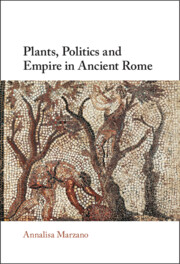Acknowledgments
This book took some years to complete. Just as trees require years to finally bear fruit, so did this book take time to grow, mature, and find its final shape.
The idea for a study addressing (some of) the themes covered in this volume started to take shape several years ago, during a wonderful conference on gardens in antiquity organized by Kathleen Coleman at the Fondation Hardt in Geneva. My first thought about making the movement of plants and botanical imperialism the subject of my next monograph was spurred by Rabun Taylor’s comment on my paper that ‘you have enough there to write a book’. The idea was then shelved for some time, while I took on the role of Head of Department, and then revisited, elaborated on, and partly changed once I could benefit from an extensive period of research leave: as Hugh Last Fellow at the British School at Rome first, and as recipient of a Leverhulme Trust Major Research Fellowship later. I am very grateful to the BSR and its Director at the time, Prof. Christopher Smith, and to the Leverhulme Trust for the support they have given to this book project.
While researching and writing sections of this book, I could also benefit from stimulating conversations during my stays as Visiting Professor at the Centre for Urban Network Evolutions of Aarhus University in May 2017 and at Nagoya University in 2019 thanks to an Invitational Fellowship by the Japan Society for the Promotion of Science. I thank Prof. Yoshiyuki Suto and Dr Yukiko Kawamoto for being excellent academic hosts.
Several friends and colleagues have helped me greatly along the way, sharing information, reading parts of the manuscript, sending me bibliographical material that was hard to access, generously allowing me to use images from their projects and publications to illustrate my text, or simply by chatting with me about themes relevant to this study. I express my heartfelt thanks to Elena Calandra, Virginia Campbell, Lanfredo Castelletti, Kathryn Gleason, Cecile Jung, Ken Lapatin, Leonor Peña-Chocarro, Phil Perkins, and Patricia Vandorpe.
I am also grateful to the CUP anonymous readers for their criticism and comments, which have helped to greatly improve the manuscript.
Finally, my warmest gratitude and thanks go to my dear friend Guy Métraux, who has read the whole manuscript (and some parts of it more than once!) before and during the evaluation process. With his characteristic intellectual acumen and eye for literary style, he has always offered detailed comments on content and presentation and, most importantly, has encouraged me to press on when it was most needed. I am greatly indebted to him and hope he will enjoy reading the final product of what has at times been a tortuous journey.

